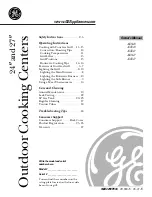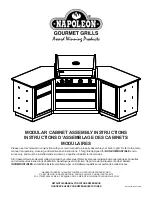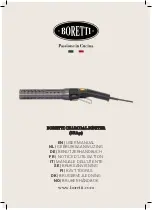
26
|
INSTALLATION / USE & CARE
Outdoor grills create more heat than interior kitchen ranges.
That’s how they sear and grill steaks and other foods.
These high-performance burners require a constant, steady
supply of fresh air to mix with the fuel. Your grill pulls air in
through the front and vents hot gases out through the rear.
Using your grill in windy conditions may disrupt the front-
to-back air fl ow. If, while grilling with all burners on high and
the hood closed, you notice that the temperature gauge fails
to rise ... be careful. If wind has kept hot gases from exiting
the rear of the grill the control panel and knobs may have
become extremely hot.
Your grill features a heat stabilizer that will defl ect wind and,
in most cases, prevent this situation.
But there are a few things you can do to further
prevent the
possibility of improper heat buildup:
•
On breezy days, be careful not to leave the front
hood down for more than 15 minutes when the burners
are on high. (Never leave the grill unattended when in
operation)If you suspect the grill is overheating, using
an oven mitt, open the front hood. Then adjust the burner
control knob to a lower setting.
• Install your grill with a wind break behind it.
• Orient the grill so prevailing winds are not blowing into the
rear of the grill.
GRILLING IN WINDY CONDITIONS
Wind hitting the back of the grill can disrupt proper exhaust.
Air enters through the front of the grill.
Please Note
: Any damage caused from use in windy conditions, such as melted knobs or igniter
wires, or control panel discoloration from heat buildup, is excluded from warranty coverage.
USING YOUR GRILL
Grilling requires high heat for searing and low, controlled
heat for slow cooking.
Thinner cuts of food are often cooked at a “HI” heat setting
with the lid open.
On the other hand, large, thick pieces of meat or poultry
are often fi rst seared at the high setting and then grilled at
a lower setting ... sometimes with the lid closed … achieving
the best results in the middle of the food without burning the
outside.
Some foods are cooked using direct heat and some using
indirect heat.
Your grill features a variety of professional-level burners and
tools for meeting the wide variety of cooking challenges. We
will reveal how these features work for you. So please read
and enjoy!
Depending on the model you chose, your grill may
be equipped with up to three diff erent burner types.
The operation of each type varies, so it is important to
understand all three.
Main Ceramic Burner
This ceramic burner is
the standard main burner
found under the briquette
trays.
Trident™ Burner
This advanced infrared burner
provides high-intensity infrared
heat for searing foods and
sealing in fl avor.
Rotisserie Burner
This infrared burner spans the back of the
cooking surface and provides consistent heat
for slow rotisserie cooking.
Summary of Contents for L54TRF-LP
Page 1: ...CARE USE INSTALLATION MAKE THE MOST OF YOUR...
Page 40: ...40 INSTALLATION USE CARE 27 30 ROTISSERIE GRILL WIRING SCHEMATICS...
Page 41: ...INSTALLATION USE CARE 41 36 42 ROTISSERIE GRILL WIRING SCHEMATICS...
Page 42: ...42 INSTALLATION USE CARE 54 ROTISSERIE GRILL WIRING SCHEMATICS...
Page 43: ...INSTALLATION USE CARE 43...
















































